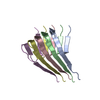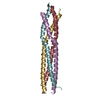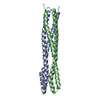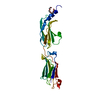+ Open data
Open data
- Basic information
Basic information
| Entry | Database: EMDB / ID: EMD-30622 | |||||||||
|---|---|---|---|---|---|---|---|---|---|---|
| Title | Cryo-EM structure of amyloid fibril formed by human RIPK3 | |||||||||
 Map data Map data | ||||||||||
 Sample Sample |
| |||||||||
 Keywords Keywords | Amyloid fibril / PROTEIN FIBRIL | |||||||||
| Function / homology |  Function and homology information Function and homology informationregulation of activation-induced cell death of T cells / regulation of CD8-positive, alpha-beta cytotoxic T cell extravasation / execution phase of necroptosis / regulation of T cell mediated cytotoxicity / regulation of activated T cell proliferation / regulation of adaptive immune response / Microbial modulation of RIPK1-mediated regulated necrosis / TRIF-mediated programmed cell death / regulation of type II interferon production / activation of protein kinase activity ...regulation of activation-induced cell death of T cells / regulation of CD8-positive, alpha-beta cytotoxic T cell extravasation / execution phase of necroptosis / regulation of T cell mediated cytotoxicity / regulation of activated T cell proliferation / regulation of adaptive immune response / Microbial modulation of RIPK1-mediated regulated necrosis / TRIF-mediated programmed cell death / regulation of type II interferon production / activation of protein kinase activity / TLR3-mediated TICAM1-dependent programmed cell death / programmed necrotic cell death / SARS-CoV-1-mediated effects on programmed cell death / necroptotic signaling pathway / RIP-mediated NFkB activation via ZBP1 / positive regulation of necroptotic process / non-canonical NF-kappaB signal transduction / RIPK1-mediated regulated necrosis / TRP channels / necroptotic process / T cell homeostasis / lymph node development / positive regulation of intrinsic apoptotic signaling pathway / spleen development / reactive oxygen species metabolic process / thymus development / TICAM1, RIP1-mediated IKK complex recruitment / IKK complex recruitment mediated by RIP1 / apoptotic signaling pathway / : / protein modification process / Regulation of necroptotic cell death / cellular response to hydrogen peroxide / positive regulation of reactive oxygen species metabolic process / SARS-CoV-1 activates/modulates innate immune responses / T cell differentiation in thymus / regulation of apoptotic process / defense response to virus / amyloid fibril formation / transcription coactivator activity / non-specific serine/threonine protein kinase / protein kinase activity / protein serine kinase activity / protein serine/threonine kinase activity / protein-containing complex binding / signal transduction / protein-containing complex / ATP binding / identical protein binding / nucleus / cytosol / cytoplasm Similarity search - Function | |||||||||
| Biological species |  Homo sapiens (human) Homo sapiens (human) | |||||||||
| Method | helical reconstruction / cryo EM / Resolution: 4.24 Å | |||||||||
 Authors Authors | Zhao K / Ma YY | |||||||||
 Citation Citation |  Journal: Proc Natl Acad Sci U S A / Year: 2021 Journal: Proc Natl Acad Sci U S A / Year: 2021Title: The structure of a minimum amyloid fibril core formed by necroptosis-mediating RHIM of human RIPK3. Authors: Xialian Wu / Yeyang Ma / Kun Zhao / Jing Zhang / Yunpeng Sun / Yichen Li / Xingqi Dong / Hong Hu / Jing Liu / Jian Wang / Xia Zhang / Bing Li / Huayi Wang / Dan Li / Bo Sun / Junxia Lu / Cong Liu /  Abstract: Receptor-interacting protein kinases 3 (RIPK3), a central node in necroptosis, polymerizes in response to the upstream signals and then activates its downstream mediator to induce cell death. The ...Receptor-interacting protein kinases 3 (RIPK3), a central node in necroptosis, polymerizes in response to the upstream signals and then activates its downstream mediator to induce cell death. The active polymeric form of RIPK3 has been indicated as the form of amyloid fibrils assembled via its RIP homotypic interaction motif (RHIM). In this study, we combine cryogenic electron microscopy and solid-state NMR to determine the amyloid fibril structure of RIPK3 RHIM-containing C-terminal domain (CTD). The structure reveals a single protofilament composed of the RHIM domain. RHIM forms three β-strands (referred to as strands 1 through 3) folding into an S shape, a distinct fold from that in complex with RIPK1. The consensus tetrapeptide VQVG of RHIM forms strand 2, which zips up strands 1 and 3 via heterozipper-like interfaces. Notably, the RIPK3-CTD fibril, as a physiological fibril, exhibits distinctive assembly compared with pathological fibrils. It has an exceptionally small fibril core and twists in both handedness with the smallest pitch known so far. These traits may contribute to a favorable spatial arrangement of RIPK3 kinase domain for efficient phosphorylation. | |||||||||
| History |
|
- Structure visualization
Structure visualization
| Movie |
 Movie viewer Movie viewer |
|---|---|
| Structure viewer | EM map:  SurfView SurfView Molmil Molmil Jmol/JSmol Jmol/JSmol |
| Supplemental images |
- Downloads & links
Downloads & links
-EMDB archive
| Map data |  emd_30622.map.gz emd_30622.map.gz | 5.1 MB |  EMDB map data format EMDB map data format | |
|---|---|---|---|---|
| Header (meta data) |  emd-30622-v30.xml emd-30622-v30.xml emd-30622.xml emd-30622.xml | 9.4 KB 9.4 KB | Display Display |  EMDB header EMDB header |
| FSC (resolution estimation) |  emd_30622_fsc.xml emd_30622_fsc.xml | 10.3 KB | Display |  FSC data file FSC data file |
| Images |  emd_30622.png emd_30622.png | 32.6 KB | ||
| Filedesc metadata |  emd-30622.cif.gz emd-30622.cif.gz | 4.8 KB | ||
| Archive directory |  http://ftp.pdbj.org/pub/emdb/structures/EMD-30622 http://ftp.pdbj.org/pub/emdb/structures/EMD-30622 ftp://ftp.pdbj.org/pub/emdb/structures/EMD-30622 ftp://ftp.pdbj.org/pub/emdb/structures/EMD-30622 | HTTPS FTP |
-Validation report
| Summary document |  emd_30622_validation.pdf.gz emd_30622_validation.pdf.gz | 337.2 KB | Display |  EMDB validaton report EMDB validaton report |
|---|---|---|---|---|
| Full document |  emd_30622_full_validation.pdf.gz emd_30622_full_validation.pdf.gz | 336.8 KB | Display | |
| Data in XML |  emd_30622_validation.xml.gz emd_30622_validation.xml.gz | 11.6 KB | Display | |
| Data in CIF |  emd_30622_validation.cif.gz emd_30622_validation.cif.gz | 15.4 KB | Display | |
| Arichive directory |  https://ftp.pdbj.org/pub/emdb/validation_reports/EMD-30622 https://ftp.pdbj.org/pub/emdb/validation_reports/EMD-30622 ftp://ftp.pdbj.org/pub/emdb/validation_reports/EMD-30622 ftp://ftp.pdbj.org/pub/emdb/validation_reports/EMD-30622 | HTTPS FTP |
-Related structure data
| Related structure data |  7da4MC  7dacC M: atomic model generated by this map C: citing same article ( |
|---|---|
| Similar structure data |
- Links
Links
| EMDB pages |  EMDB (EBI/PDBe) / EMDB (EBI/PDBe) /  EMDataResource EMDataResource |
|---|---|
| Related items in Molecule of the Month |
- Map
Map
| File |  Download / File: emd_30622.map.gz / Format: CCP4 / Size: 91.1 MB / Type: IMAGE STORED AS FLOATING POINT NUMBER (4 BYTES) Download / File: emd_30622.map.gz / Format: CCP4 / Size: 91.1 MB / Type: IMAGE STORED AS FLOATING POINT NUMBER (4 BYTES) | ||||||||||||||||||||||||||||||||||||||||||||||||||||||||||||||||||||
|---|---|---|---|---|---|---|---|---|---|---|---|---|---|---|---|---|---|---|---|---|---|---|---|---|---|---|---|---|---|---|---|---|---|---|---|---|---|---|---|---|---|---|---|---|---|---|---|---|---|---|---|---|---|---|---|---|---|---|---|---|---|---|---|---|---|---|---|---|---|
| Projections & slices | Image control
Images are generated by Spider. | ||||||||||||||||||||||||||||||||||||||||||||||||||||||||||||||||||||
| Voxel size | X=Y=Z: 1.06 Å | ||||||||||||||||||||||||||||||||||||||||||||||||||||||||||||||||||||
| Density |
| ||||||||||||||||||||||||||||||||||||||||||||||||||||||||||||||||||||
| Symmetry | Space group: 1 | ||||||||||||||||||||||||||||||||||||||||||||||||||||||||||||||||||||
| Details | EMDB XML:
CCP4 map header:
| ||||||||||||||||||||||||||||||||||||||||||||||||||||||||||||||||||||
-Supplemental data
- Sample components
Sample components
-Entire : human RIPK3-CTD amyloid fibril
| Entire | Name: human RIPK3-CTD amyloid fibril |
|---|---|
| Components |
|
-Supramolecule #1: human RIPK3-CTD amyloid fibril
| Supramolecule | Name: human RIPK3-CTD amyloid fibril / type: organelle_or_cellular_component / ID: 1 / Parent: 0 / Macromolecule list: all |
|---|---|
| Source (natural) | Organism:  Homo sapiens (human) Homo sapiens (human) |
-Macromolecule #1: Receptor-interacting serine/threonine-protein kinase 3
| Macromolecule | Name: Receptor-interacting serine/threonine-protein kinase 3 type: protein_or_peptide / ID: 1 / Number of copies: 3 / Enantiomer: LEVO / EC number: non-specific serine/threonine protein kinase |
|---|---|
| Source (natural) | Organism:  Homo sapiens (human) Homo sapiens (human) |
| Molecular weight | Theoretical: 15.311755 KDa |
| Recombinant expression | Organism:  |
| Sequence | String: MGSSDSMAQP PQTPETSTFR NQMPSPTSTG TPSPGPRGNQ GAERQGMNWS CRTPEPNPVT GRPLVNIYNC SGVQVGDNNY LTMQQTTAL PTWGLAPSGK GRGLQHPPPV GSQEGPKDPE AWSRPQGWYN HSGKLEHHHH HH UniProtKB: Receptor-interacting serine/threonine-protein kinase 3 |
-Experimental details
-Structure determination
| Method | cryo EM |
|---|---|
 Processing Processing | helical reconstruction |
| Aggregation state | helical array |
- Sample preparation
Sample preparation
| Buffer | pH: 5 |
|---|---|
| Vitrification | Cryogen name: ETHANE |
- Electron microscopy
Electron microscopy
| Microscope | FEI TITAN KRIOS |
|---|---|
| Image recording | Film or detector model: GATAN K3 BIOQUANTUM (6k x 4k) / Average electron dose: 55.0 e/Å2 |
| Electron beam | Acceleration voltage: 300 kV / Electron source:  FIELD EMISSION GUN FIELD EMISSION GUN |
| Electron optics | Illumination mode: FLOOD BEAM / Imaging mode: BRIGHT FIELD |
| Experimental equipment |  Model: Titan Krios / Image courtesy: FEI Company |
 Movie
Movie Controller
Controller





















 Z (Sec.)
Z (Sec.) Y (Row.)
Y (Row.) X (Col.)
X (Col.)






















